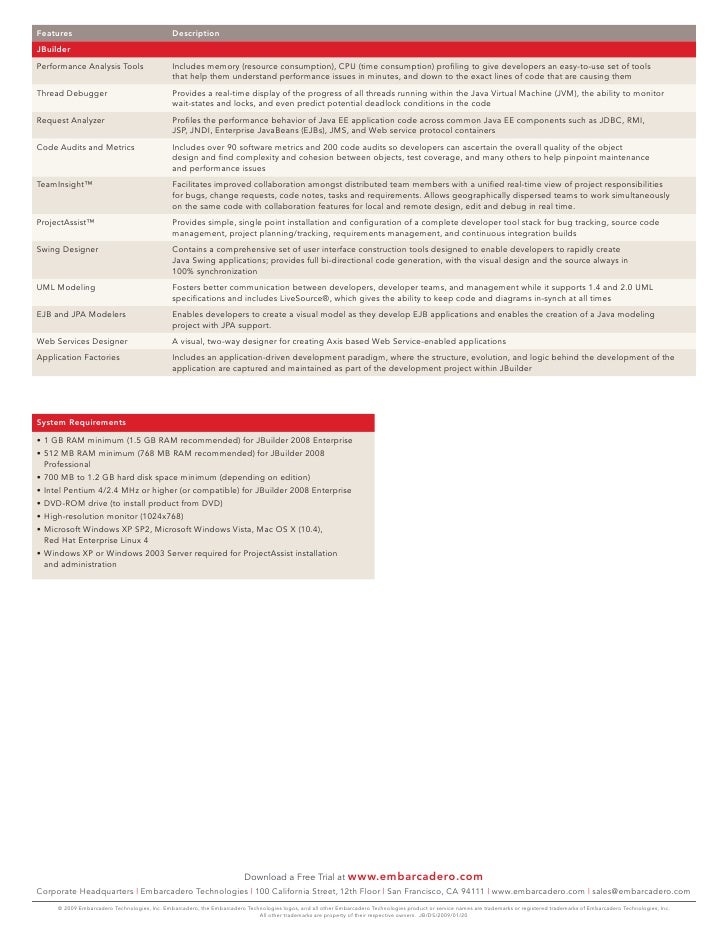Jbuilder 4 Download


Aimed at hard-core de-velopers rather than advanced designers, JBuilder packs plenty of powerand a handful of wizards and other quick-start tools for the middle tier. JBuilder is a robust and slick performer for creating Java components, and it offers some promising JSP abilities, too. JBuilder itself is built on Java and Swing (Java's GUI framework), making for outstanding cross-platform support: It runs on Windows, Linux, and Solaris with the same interface and tools. This 'all-Java' approach means it takes a little more RAM to run JBuilder: 128MB is the minimum; we recommend 256MB to get real performance.
As with previous versions, the JBuilder 4 IDE is a model of productivity and powerfully elegant design. You can easily view Java, HTML, and JSP files in the same environment. Bundling Sun's new JDK 1.3 HotSpot virtual machine, which optimizes Java code under the hood, JBuilder has a surprisingly responsive interface. Among many appealing features, we liked the slick auto-completion wizardry, which supplies not only on-the-fly help with methods but also parameters as you type Java code.
JBuilder 4 Enterprise truly shines in its support for building Enterprise Java-Bean components. JBuilder supports EJB 1.1 and, thanks to a flexible XML-based solution, is ready for 2.0 when it arrives next year. You can generate EJB Java classes automatically, based on tables on the back end, and JBuilder even simplifies automating EJB deployment. There's CORBA support, too, with wizards that help manage the details of IDL (the interface definition language required by distributed apps) and getting to remote objects. For local development, JBuilder relies on the included lightweight Java database called JDataStore. In testing, we modeled classes and built EJBs for sample data in JDataStore, then deployed the finished versions to Oracle 8i. The included JDataStore Explorer and JDBC Explorer let you administer JDataStore and any JDBC-compliant data source.
Please select the platform, language and version you would like to download. Exercise: Download JBuilder Foundation Java compiler and development environment from Borland website, install it, and use a small program for testing it and. Jbuilder 5 free download setup for Windows. It is full offline installer standalone setup of JBuilder 5 Java programming IDE Compiler for both 32bit 64 bit.
Cutting Master 3 Software here. For testing, we built a JSP-based Web application on top of EJBs on the middle tier. JBuilder handled this with ease. Though it's easy to create a default JSP in JBuilder, you do so through a rudimentary HTML form rather than in a specific tool like that in WebSphere Studio.
JSP is still a relatively new technology to JBuilder; you manage JavaServer Pages with a simple JavaBean. JBuilder 4 Enterprise is bundled with more than 300 components, most of which are JavaBeans and Swing controls, useful for building client-side applets and standalone Java applications. There are 16 special controls called InternetBeans, however, dedicated to JSPs and servlets. These components encapsulate controls used in Web formsfrom simple buttons to advanced features such as tables.
These objects keep HTML and the underlying JSP/servlet code separate so that Web designers can change HTML without having to call on Java programmers to update underlying code. This solution looks promising to us, offering plenty of room for growth. In fact, the same components let you generate WML for wireless devices. You just change the template to WML, and these InternetBeans will dynamically fill in the blanks with data for a WAP-enabled cell phone. We did miss the ability to design HTML in JBuilder visually, though we could edit HTML source code and even preview our evolving design.